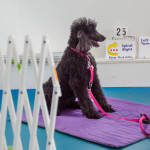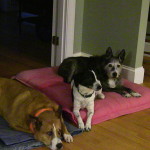Looking at this dogs body language, the boxer is leaning away from his best friend, his ears are pinned back in fear, the whites of his eyes show the level of stress. This dog is not thinking about what he did but how he feels right now. Why does it matter how a dog feels? Because his feelings will effect his behavior. Dogs will often avoid humans who make them feel stressed or worried.
In contrast, look at the body language of these two young girls, and how they are making each other feel? This is a baby sitter and a child she is responsible for. The baby sitter is building trust, mutual communication and a connection. We can see a positive relationship building based on body language.

The body language of this Scottie is pretty clear how is she feels about the hand petting her. She was just groomed by the hand now petting her, do we have a trusting relationship, mutual communication and a connection?
When I introduce a new rule structure to my dogs or my clients dog, I make sure good things happen when the dog performs the wanted or desired behavior. We can all agree that consequence drives behavior in all of us, but I want you to think of a consequence as a rewarding one. It is not just that I believe it works, it is scientifically proven that if a dog does a behavior and what follows is rewarding, the behavior will be repeated. This repeated behavior performed several times per day and continued over a few weeks becomes a desired habit. Is that not what we all are trying to do? Shape our dogs behavior into good habits?
Below is an Example of how I make a dog feel during a training session.
With a foster dog, I grab a handful of treats and lure the dog to his mat, if he sniffs it, looks at it or step on it, I say “yes” or  click my clicker and drop a treat or two between his paws. Then I ask the dog to get off his mat, pick it up and walk a few steps with it in my hand. I repeat the process of laying the mat down and rewarding the dog for moving onto the mat. When he steps onto it, say “yes” and reward generously. Initially, put the mat away between sessions and play this game a few times per day. When your see your dog get excited that you are about to lay the mat down, add a cue like “go to your place” just before you lay the mat down. Once your dog is walking on the mat quickly, wait on the “yes” and see if your dog offers you a sit, then say “yes” and reward. Eventually your dog will offer you a down and then you can jackpot this behavior.
click my clicker and drop a treat or two between his paws. Then I ask the dog to get off his mat, pick it up and walk a few steps with it in my hand. I repeat the process of laying the mat down and rewarding the dog for moving onto the mat. When he steps onto it, say “yes” and reward generously. Initially, put the mat away between sessions and play this game a few times per day. When your see your dog get excited that you are about to lay the mat down, add a cue like “go to your place” just before you lay the mat down. Once your dog is walking on the mat quickly, wait on the “yes” and see if your dog offers you a sit, then say “yes” and reward. Eventually your dog will offer you a down and then you can jackpot this behavior.
To maintain the desired behavior of “go to your mat” I will randomly reward my dog when I see him go to his mat without being asked. Rewards can be a slow massage, stuffed yummy kong time, favorite chew bone, yummy treat, a good scratch, whatever your dog finds rewarding. I use this each morning as we enter the kitchen, each of my dogs will move towards their mat and I will eventually feed them while they are on their mat waiting patiently. I no longer ask them to go to their mat, they know going to their mat predicts they will get fed, which is rewarding to them and nice for me to have then out of the kitchen.
 If you are reading this Blog, then I assume you have a dog or are thinking about getting a dog. My hope is that you are a positive influence in training your dog, and not one who feels they need to “dominate” a dog. Consider how your behavior makes your dog “feel” when you are training. I hope your dog feels good when you are near, when he looks at you and when you reach to touch him. If not, read more of my blog to learn how to train your dog while also having a happy, healthy and trusting relationship.
If you are reading this Blog, then I assume you have a dog or are thinking about getting a dog. My hope is that you are a positive influence in training your dog, and not one who feels they need to “dominate” a dog. Consider how your behavior makes your dog “feel” when you are training. I hope your dog feels good when you are near, when he looks at you and when you reach to touch him. If not, read more of my blog to learn how to train your dog while also having a happy, healthy and trusting relationship.
Remember, how you make a dog or friend feel, will effect the relationship. In my experiences, your dog will not remember what you say, but he will remember how you make him feel.




